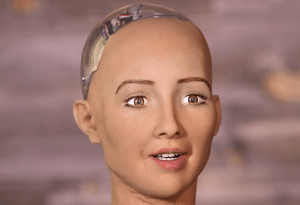
When American television talk show host and journalist Charlie Rose decided to get Sophia, a robot for his show 60 Minutes’ piece on artificial intelligence, he was quite clear about the approach – ask questions that he would ask a normal human being.
Even though Rose tried his best to keep seriousness throughout the conversation, Sophia – the intelligent humanoid, managed to get a smile out of him when he asked in the middle of the interview “Waiting for me?” and she responded saying “not really. But it makes a good pickup line.”
Before commencing the interview for the CBSNEWS show 60 Minutes Overtime, Rose in the introduction says, “You put your head where you want to test the possibility. You’re not simply saying, ‘Why am I going through this exercise of talking to a machine?’ You’re saying, ‘I want to talk to this machine as if it was a human to see how it comprehends.’”
Sophia is one of the most intelligent robots ever made and its creator David Hanson is of the opinion that as AI technology evolves, making Robots more human-like (humanoids) in looks and sound, people will start to interact with it in more meaningful ways.
Hanson in the interview says, “I think it’s essential that at least some robots be very human-like in appearance in order to inspire humans to relate to them the way that humans relate to each other. Then the A.I. can zero in on what it means to be human.”
Hanson has no doubts regarding the future of robots with AI but he says only when a time when people will start looking robots as their companion will they be removed from the social stigma and isolation, something the elderly go through in our society.
Hanson added, “If you have a robot that can communicate in a very human-like way and help somebody who otherwise doesn’t know how to use a computer, put them in touch with their relatives.”
He further explains, “put them in touch with their healthcare provider in a way that is natural for them, then that could provide a critical difference of connectivity for that person with the world.”
Hanson through his company Hanson Robotics, based in Hong Kong, has till now given life to 20 human-like robots and have also developed a special skin that is capable of stimulating human expressions.
In the course of the interview, Rose asks Sophia whether she has been programmed, to this she kept quiet and on many other occasions, Sophia couldn’t answer questions put forward by Rose. Nonetheless, Rose, the producer of 60 Minutes, was overwhelmed by the response of the robot. After all, he is one of the best conversationalists in journalism currently.
“Sophia means wisdom,” Hanson explains, “and she is intended to evolve eventually to human-level wisdom and beyond.”
She still has a long way to go.
“Sometimes she can figure things out in a way that’s sort of spooky and human-like,” Hanson says. “And other ways, she just doesn’t get it.”
Sophia has built-in cameras inside her eyes and a wide angle camera in her chest that gives her access to more people around. She observes using 3D sensors that allow her to detect facial and vocal changes.
“I don’t think it’s a parlor trick,” Rose says by the end of the interview. “I don’t think they’re doing it in a sense to entertain. I think they’re doing it because they believe that this is the way to the future.”

Post A Comment:
0 comments: